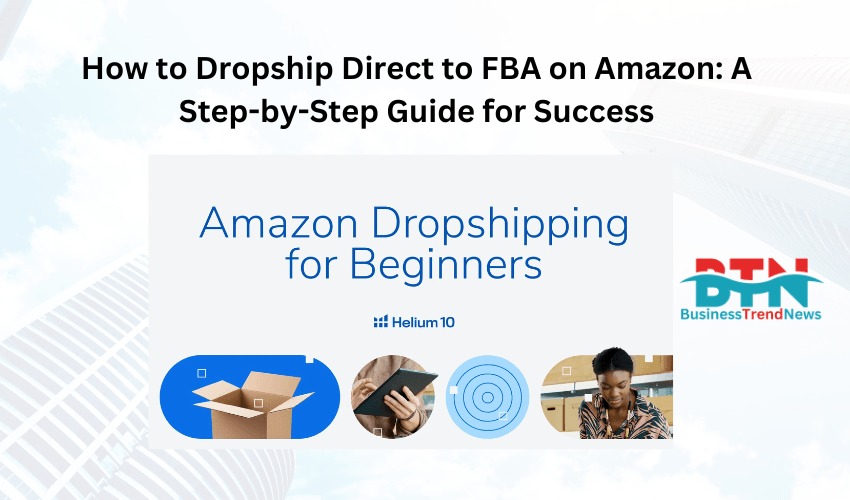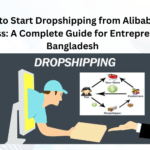![]()
How to Dropship Direct to FBA on Amazon: A Step-by-Step Guide for Success
Dropshipping has long been a popular business model due to its low upfront costs and minimal inventory requirements. However, combining dropshipping with Amazon’s Fulfillment by Amazon (FBA) service opens up even more lucrative possibilities. This approach allows sellers to leverage Amazon’s vast logistics network to store, pick, pack, and ship their products to customers. In this comprehensive guide, we’ll explain how to dropship direct to FBA on Amazon, covering everything from setting up your seller account to optimizing your operations for long-term success.
Table of Contents:
- What is Dropshipping and FBA?
- Advantages of Combining Dropshipping with FBA
- Setting Up Your Amazon Seller Account
- Finding the Right Suppliers for Dropshipping to FBA
- Steps to Dropshipping Direct to FBA
- Managing Inventory and Shipping to FBA Warehouses
- Optimizing Listings for Amazon Success
- Legal Considerations for Dropshipping and FBA
- Common Mistakes to Avoid
- Scaling Your Business with Dropshipping and FBA
- Conclusion
1. What is Dropshipping and FBA?
Before diving into the intricacies of combining dropshipping with FBA, it’s essential to understand both business models:
- Dropshipping: This involves selling products without holding inventory. When a customer places an order, you purchase the item from a supplier, who then ships it directly to the customer. The seller acts as a middleman, focusing on marketing and customer service.
- Fulfillment by Amazon (FBA): FBA is Amazon’s fulfillment service where sellers can send their inventory to Amazon’s warehouses. Amazon then handles storage, packaging, shipping, and even customer service for those products.
Combining these models allows sellers to source products from suppliers (like Alibaba) and ship them directly to Amazon’s fulfillment centers. Amazon then takes care of the rest, offering benefits like Prime eligibility, faster shipping, and robust customer service.
2. Advantages of Combining Dropshipping with FBA
Combining dropshipping with Amazon FBA offers numerous advantages that can help your business grow:
- Prime Eligibility: When you use FBA, your products become eligible for Amazon Prime, which gives customers faster shipping options and increases your product’s visibility.
- Better Customer Service: Amazon handles returns, refunds, and customer inquiries for FBA products, saving you time and effort.
- Lower Shipping Costs: Shipping large volumes of products to Amazon’s FBA warehouses typically results in lower shipping costs, compared to shipping products individually to customers.
- Focus on Sales: With inventory and shipping taken care of by Amazon, you can focus on marketing, customer acquisition, and scaling your business.
- Boosted Credibility: Selling on Amazon, with its trusted brand and vast customer base, increases the likelihood of customer trust and conversions.
3. Setting Up Your Amazon Seller Account
The first step to dropshipping directly to FBA on Amazon is setting up an Amazon seller account. Here’s how to get started:
- Create an Amazon Seller Account: Head over to Amazon’s Seller Central page and sign up for an account. You’ll have two options: an Individual or Professional seller account. The Professional account is recommended if you plan to sell more than 40 items per month.
- Set Up Your FBA Account: Once your seller account is ready, you can enable Fulfillment by Amazon (FBA). Go to your Seller Central dashboard, navigate to “Inventory,” and select “Manage FBA Inventory” to get started.
- Tax and Payment Information: Amazon will require you to input your business details, including tax and bank account information. Make sure all details are accurate, as this is essential for getting paid.
- Set Up Shipping Settings: Amazon will prompt you to set up your shipping preferences for sending products to FBA warehouses. Make sure you follow Amazon’s guidelines to ensure smooth fulfillment.
4. Finding the Right Suppliers for Dropshipping to FBA
One of the most critical aspects of dropshipping to FBA is finding reliable suppliers. Many sellers opt for suppliers from Alibaba or AliExpress, but you can also explore manufacturers and wholesalers closer to home.
Key Considerations When Choosing Suppliers:
- Product Quality: Since Amazon has strict guidelines, especially for FBA products, you need to ensure that the products meet high-quality standards.
- Shipping Reliability: Your supplier must reliably ship products to Amazon’s warehouses on time to avoid any delays in the fulfillment process.
- Communication: Working with suppliers that provide clear and timely communication is essential, especially when handling large orders or resolving issues.
- Private Label Options: Many dropshipping sellers combine private labeling with their FBA strategy. Find suppliers who allow customization of products or packaging with your brand.
5. Steps to Dropshipping Direct to FBA
To streamline the process, follow these steps for dropshipping directly to FBA:
Step 1: Research and Source Products
Begin by researching products that are in demand on Amazon. Use tools like Jungle Scout, Helium 10, or AMZScout to analyze product competition, price, and sales volume. After identifying potential products, source them from suppliers who meet Amazon’s quality and delivery requirements.
Step 2: Create a Shipment Plan
Once you’ve selected the products and agreed with the supplier, create a shipment plan in Amazon Seller Central. Amazon will guide you through labeling, packaging, and sending products to their fulfillment centers. Your supplier may assist with labeling if needed.
Step 3: Ship Products to FBA
Coordinate with your supplier to ship the products directly to Amazon’s fulfillment centers. Be sure that the products are packaged correctly according to Amazon’s guidelines, as improper packaging can lead to delays or rejections.
Step 4: List Your Products on Amazon
Create listings for your products on Amazon, making sure to optimize them with relevant keywords, high-quality images, and detailed descriptions (we’ll cover listing optimization in detail later).
Step 5: Amazon Receives and Stores Your Products
After your products arrive at the FBA warehouse, Amazon will inspect, sort, and store them. Your listings will go live, and customers can start purchasing your products.
Step 6: Customer Orders Fulfilled by Amazon
Once a customer places an order, Amazon takes care of everything: picking, packing, shipping, and even handling customer service.
6. Managing Inventory and Shipping to FBA Warehouses
Effective inventory management is crucial when combining dropshipping with FBA. If your inventory runs out, you could lose the Amazon Buy Box and potential sales.
Best Practices for Inventory Management:
- Monitor Inventory Levels: Use tools like Restock Pro or Amazon’s FBA inventory dashboard to track stock levels and prevent stockouts.
- Order in Bulk: To cut costs, consider ordering products in bulk from your supplier and sending them to multiple FBA warehouses.
- Automate Reordering: Set up automatic reorder points for when stock levels dip below a certain threshold. This ensures seamless inventory replenishment and prevents disruptions in sales.
7. Optimizing Listings for Amazon Success
To maximize sales, you need to ensure that your product listings are optimized for Amazon’s search engine (A9 algorithm). Here are some key tips:
Optimize Product Titles:
Include relevant keywords, brand names, and unique selling points in your product titles. Keep the title concise yet descriptive.
Use High-Quality Images:
Amazon allows up to 9 images per product. Ensure that your images are high resolution, showcase different angles of the product, and include lifestyle shots where applicable.
Write Compelling Product Descriptions:
Your product descriptions should clearly outline the product’s features and benefits. Use bullet points for readability and include keywords naturally.
Leverage Customer Reviews:
Encourage satisfied customers to leave positive reviews, as this will boost your product’s credibility and ranking on Amazon.
8. Legal Considerations for Dropshipping and FBA
There are several legal aspects to be aware of when dropshipping directly to Amazon FBA:
- Sales Tax Compliance: Depending on where your business and customers are located, you may need to collect and remit sales tax. Use a tool like TaxJar to manage tax obligations across different states.
- Product Liability: Ensure that the products you sell meet safety standards, particularly if they are in a regulated category (e.g., toys, electronics). You may also want to consider purchasing product liability insurance.
- Terms of Service: Amazon has strict policies around dropshipping. Make sure to familiarize yourself with Amazon’s dropshipping policies to avoid account suspension.
9. Common Mistakes to Avoid
Dropshipping to FBA can be highly profitable, but there are pitfalls to avoid:
- Not Vetting Suppliers: Failing to properly vet suppliers can result in low-quality products or delays in shipment, which can lead to negative customer feedback.
- Underestimating Costs: Consider all costs, including FBA fees, shipping fees, storage fees, and Amazon referral fees, to ensure that you maintain healthy profit margins.
- Ignoring Listing Optimization: Simply listing products on Amazon won’t guarantee success. Optimizing your listings for SEO and conversion is crucial.
10. Scaling Your Business with Dropshipping and FBA
Once your dropshipping and FBA business is running smoothly, you can begin scaling your operations by expanding your product line, investing in marketing, and improving operational efficiency.
- Diversify Product Offerings: Use market research tools to identify new products with high demand and low competition.
- Automate Processes: Use software tools to automate inventory management, customer communication, and order fulfillment, allowing you to focus on growth.
- Leverage Amazon Advertising: Sponsored product ads and other forms of Amazon advertising can help increase visibility and drive more sales.
11. Conclusion
Combining dropshipping with Amazon FBA offers an excellent opportunity for entrepreneurs looking to build a successful online business without the need for upfront inventory investment. By leveraging Amazon’s fulfillment services, you can provide your customers with fast, reliable shipping, focus on marketing, and grow your business efficiently. Remember, success in this business model hinges on choosing the right products, finding reliable suppliers, optimizing your Amazon listings, and staying compliant with Amazon’s rules. Follow the steps outlined in this guide, and you’ll be well on your way to building a profitable dropshipping business on Amazon FBA.



